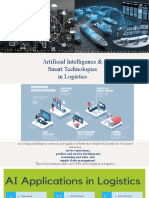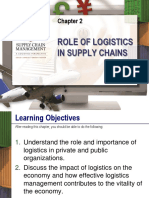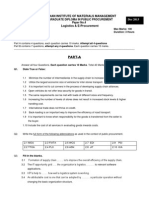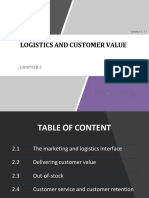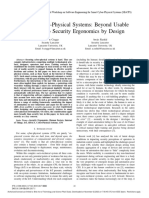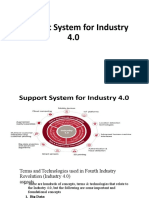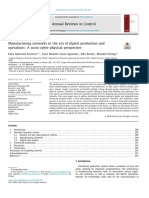Logistics 4.0
Uploaded by
jihanemanar72Logistics 4.0
Uploaded by
jihanemanar72Logistics 4.
0
Introduction
With the 4th industrial revolution, new technologies, such as artificial
intelligence, cloud computing, 3D printers and the Internet of Things
started to take greater prominence in the world of business.
The influence of automation and digitization has huge impacts on
work–life balance, social life and industry worldwide.
If a company intends to compete in the market, it has to adapt itself to
newly arising technologies.
One of the sectors affected by the process that started with Industry 4.0
is logistics.
Introduction
Industry 4.0 shows that logistics companies should keep up with such
technological advances.
Since logistics is a highly engaged and central sector that is crucial for
industry, it must adapt itself to these innovations.
For that reason, a concept called Logistics 4.0 has emerged.
The concept of Logistics 4.0 denotes a process that causes an
increase in efficiency and a decrease in the costs of automation.
Evolution of Logistics
The four levels of warehouse handling systems
The Concept of Logistics 4.0
Logistics businesses can create a difference by offering logistic
services that goes beyond the expectation of customers.
Using information technology makes it easier for businesses to keep
payment, order and inventory records and tracking their customers.
Information technology is especially to be used in individualization,
consolidation, labeling and packaging, which all offer solutions with
significant benefits.
Logistics 4.0 as a new logistic system that is flexible, transparent,
adaptable to market fluctuations, that lowers costs and supplies
customer needs in the fastest and plentiful way
The Concept of Logistics 4.0
The Concept of Logistics 4.0
The Concept of Logistics 4.0
Logistics 4.0 consists of autonomous subsystems where the behavior of
individual actors depends on other actors. These autonomous systems
interact with each other in order to reach their individual goals and to
ensure that the relevant parties can reach their goals.
The technical components of Logistics 4.0 are as follows:
i. Automatic Identification (RFID Technology)
ii. Real-time Locating Systems (RTLS)
iii. Smart Sensing (CPS, sensors)
iv. Networking (IoT, IoS, etc.)
v. Data analyzing (Big data, data mining)
vi. Internet for business service (IoS, ERP, Marketing)..
Supply Chain Management 4.0
A supply chain is a network of suppliers, factories, warehouses,
distribution centers, retailers, and customers throughout the purchase,
conversion, production, and delivery of raw materials.
Supply chain management is a series of concurrent activities that
enable the integration of suppliers, manufacturers, carriers, and
customers to ensure that the right product or service is delivered to the
right places at the right time
Businesses are forced to expand their offer of products in order to
remain competitive in the market. As a result, they offer a high degree
of flexibility in supply chains, with a high degree of uncertainty.
Failures to cope with these uncertainties
Supply Chain Management 4.0
As a result, the right products cannot be delivered to the customer at
the right time
Such a situation is not only the problem of the company, but also
because of the high dependence of the supply chain can affect other
companies do business.
The supply chain, which is a complex network, conducts these
activities effectively and efficiently depends on the rapid flow of
information and material
Information technology is becoming an increasingly important issue
because supply networks are transforming into cyber physical
systems, one of the key elements of Industry 4.0
Supply Chain Management 4.0
Cyber-physical systems
Cyber-physical systems are used in urban traffic control, emergency
response units, and security control networks. Cyber-physical systems
have both the information processing layer and the physical layers.
These systems work in conjunction with other cyber-physical systems
and take their decisions in harmony and perform their tasks in a
coordinated manner
Performing identification, real-time monitoring, and tracking and
control functions in supply chain management can often involve many
difficulties. The main reasons for this situation include the presence of
many stakeholders in the system. IoT brings significant solutions to
the problems that arise in this regard.
Supply Chain Management 4.0
Internet of things
Logistics is a key player prepared to benefit from the IoT revolution. It
is not very surprising that IoT and logistics are a perfect match since
every day millions of consignments are being handled, carried, tracked
and stacked by various machines, tools and humans.
In logistics, IoT can connect different entities meaningfully throughout
a supply chain and then, can analyze the data obtained from these
new connections in order to spot potential improvement
Thus, IoT leads to higher operational efficiency for logistics providers
by creating dynamic and automatic services that are specifically tuned
for their customers.
Supply Chain Management 4.0
Augmented reality
AR (Augmented Reality) can provide some significant benefits.
AR can provide the logistics providers with fast access to expected
information anytime and from anywhere.
This is important in order to fully plan and execute intended duties
such as delivery and loading optimization, and also in order to provide
a better customer service.
Most substantial AR solutions in logistics are the ones that optimize
the collection process
Supply Chain Management 4.0
3D printing
There is an opportunity that the customer can print the product with 3D
printing technology as a complete final product from a printer, at any
time, in any place with desired features;
This new manufacturing structure will cause a change in supply chain
management
Because with 3D printing, by using only digital files, raw material and
printers, final product can be obtained close to the customer
This customized manufacturing structure will decrease the stock
amount, square meter of required warehouse area and transportation
number.
The growing requirement for mass customization and on-demand
printing will force the roles of the supply chain participants like
manufacturers, wholesalers, retailers and logistics providers.
Exemple : UPS chose to work with partners as SAP, Fast Radius or
Adidas “Speedfactory
Supply Chain Management 4.0
The potential of Robotics
Robotics are used in warehouse operations that are an important part
of logistics. Since routine activities are performed in warehouses in
general, the usage of static and nonautonomous or semi-autonomous
robotics is enough to run warehouse operations.
A range of warehousing operations such as order picking, product
sorting, and preparing the dispatch that proper to customer orders
requires to use of intensive human force already. From this point of
view, supply chains and companies should increase the usage of
smart and autonomous robotic systems in the warehousing operations
to keep their competitive power
Supply Chain Management 4.0
Cloud Information Systems
With the development of information technologies, the needs such as
transferring and storing data, and providing quick access to the data
have arisen. Cloud service providers have emerged on these needs.
Businesses can stream and store data, and access it at any time over
a fixed portal thanks to cloud service providers which have advantages
such as low storage costs, working with cross platforms, fast data flow
and access facilities at any time
The control of logistics sector in which various processes such as
transportation storage, distribution, vehicle tracking, and finance are
managed simultaneously has become much easier due to the
advantages provided by cloud technology.
Key benefits of Logistics 4.0
Greater transparency and accuracy
Leading to cost savings
Increased interconnectedness
Improved warehouse management
Intelligent’ supply chain.
Greater Agility.
You might also like
- WHY ENGLISH? - The English Language As A Tool of International CommunicationNo ratings yetWHY ENGLISH? - The English Language As A Tool of International Communication6 pages
- The Internet Is A Driving Force For ChangeNo ratings yetThe Internet Is A Driving Force For Change2 pages
- Professional English For Students of Logistics PDF100% (1)Professional English For Students of Logistics PDF187 pages
- An Intro To Pharma 4.0: Implementing Industry 4.0 in Highly Regulated Industries100% (1)An Intro To Pharma 4.0: Implementing Industry 4.0 in Highly Regulated Industries23 pages
- Flash On English Transport and LogisticsNo ratings yetFlash On English Transport and Logistics50 pages
- Lecture 1 - Introduction To Logistics and DistributionNo ratings yetLecture 1 - Introduction To Logistics and Distribution13 pages
- CHAPTER 4i The Synchronous Supply Chain - AHMRNo ratings yetCHAPTER 4i The Synchronous Supply Chain - AHMR34 pages
- Project Management: The Managerial Process 8th Edition Larson All Chapters Instant DownloadNo ratings yetProject Management: The Managerial Process 8th Edition Larson All Chapters Instant Download51 pages
- English For Information and Technology: Chapter TwoNo ratings yetEnglish For Information and Technology: Chapter Two8 pages
- PD10 Sourcing and Procurement Materials V2 5100% (1)PD10 Sourcing and Procurement Materials V2 5254 pages
- Principles of Logistics Transport ManagementNo ratings yetPrinciples of Logistics Transport Management18 pages
- Logistics Ok MASTER I Logistics - SEM INo ratings yetLogistics Ok MASTER I Logistics - SEM I59 pages
- Letter For Acknowledging Delivery of Goods or ServicesNo ratings yetLetter For Acknowledging Delivery of Goods or Services1 page
- Full Download Supply Chain Management Text and Cases 2nd Edition Janat Shah PDF DOCX100% (1)Full Download Supply Chain Management Text and Cases 2nd Edition Janat Shah PDF DOCX54 pages
- CHAPTER - 1b - Logistics & Customer ValueNo ratings yetCHAPTER - 1b - Logistics & Customer Value19 pages
- Chapter 9 - Informal Reports (9-1, 9-2, 9-3)No ratings yetChapter 9 - Informal Reports (9-1, 9-2, 9-3)20 pages
- Airport Logistics: and The Air Cargo Supply ChainNo ratings yetAirport Logistics: and The Air Cargo Supply Chain34 pages
- Operations Management Customer Tailored Logistics Group-8: PGDM 2018-2020No ratings yetOperations Management Customer Tailored Logistics Group-8: PGDM 2018-202012 pages
- Transportation Engineerig Paper PresentationNo ratings yetTransportation Engineerig Paper Presentation14 pages
- CIPS Global Standard Segment 3.1 Understanding Systems For Procurement and SupplyNo ratings yetCIPS Global Standard Segment 3.1 Understanding Systems For Procurement and Supply3 pages
- Chapter 05 Short Workplace Messages and Digital MediaNo ratings yetChapter 05 Short Workplace Messages and Digital Media45 pages
- Chapter 10 Proposals and Formal ReportsNo ratings yetChapter 10 Proposals and Formal Reports51 pages
- Information Technology in Logistics ManagementNo ratings yetInformation Technology in Logistics Management28 pages
- Chapter 6 - International Logistics, Risks InsuranceNo ratings yetChapter 6 - International Logistics, Risks Insurance41 pages
- LOGISTICS 4.0: Embracing Technology in Supply Chain TransformationFrom EverandLOGISTICS 4.0: Embracing Technology in Supply Chain TransformationNo ratings yet
- The_Impact_of_Industry_4_on_Supply_chain_ManagementNo ratings yetThe_Impact_of_Industry_4_on_Supply_chain_Management23 pages
- Format - Guidelines For KSCST Project Proposal (2014-2015)No ratings yetFormat - Guidelines For KSCST Project Proposal (2014-2015)10 pages
- An Alphabetical Version of The CyBOK 19 Knowledge Areas Indicative Material ITN3hpf PDFNo ratings yetAn Alphabetical Version of The CyBOK 19 Knowledge Areas Indicative Material ITN3hpf PDF15 pages
- Computational Models For Embedded Systems: Associate Professor Andreea VescanNo ratings yetComputational Models For Embedded Systems: Associate Professor Andreea Vescan31 pages
- Chiang, Journal, 2016 - Unknown - Fog and IoT An Overview of Research OpportunitiesNo ratings yetChiang, Journal, 2016 - Unknown - Fog and IoT An Overview of Research Opportunities11 pages
- Smart Cyber-Physical Systems Beyond Usable Security To Security Ergonomics by DesignNo ratings yetSmart Cyber-Physical Systems Beyond Usable Security To Security Ergonomics by Design4 pages
- Process Safety and Environmental ProtectionNo ratings yetProcess Safety and Environmental Protection11 pages
- Manufacturing Networks in The Era of Digital Production and Operations - 2020No ratings yetManufacturing Networks in The Era of Digital Production and Operations - 20207 pages
- Construction 4.0, PLAN, Four Layer IntegrationNo ratings yetConstruction 4.0, PLAN, Four Layer Integration14 pages
- Human-Cyber-Physical Systems (HCPSS) in The Context of New-Generation Intelligent Manufacturing (Industry 4.0) and The Barriers To Implement Industry 4.0 INo ratings yetHuman-Cyber-Physical Systems (HCPSS) in The Context of New-Generation Intelligent Manufacturing (Industry 4.0) and The Barriers To Implement Industry 4.0 I30 pages
- White Paper: 5G Evolution: On The Path To 6GNo ratings yetWhite Paper: 5G Evolution: On The Path To 6G47 pages
- Reference Architecture and Maturity Levels For Cyber-Physical Systems in The Mechanical Engineering Industry PDFNo ratings yetReference Architecture and Maturity Levels For Cyber-Physical Systems in The Mechanical Engineering Industry PDF6 pages
- Industry 4.0 Revolution in Clothing and Apparel Factories: Apparel 4.0No ratings yetIndustry 4.0 Revolution in Clothing and Apparel Factories: Apparel 4.017 pages
- Master: Mechatronic and Cyber-Physical SystemsNo ratings yetMaster: Mechatronic and Cyber-Physical Systems2 pages
- Instrumen Tes Berbasis Literasi Sains EnergiNo ratings yetInstrumen Tes Berbasis Literasi Sains Energi11 pages









